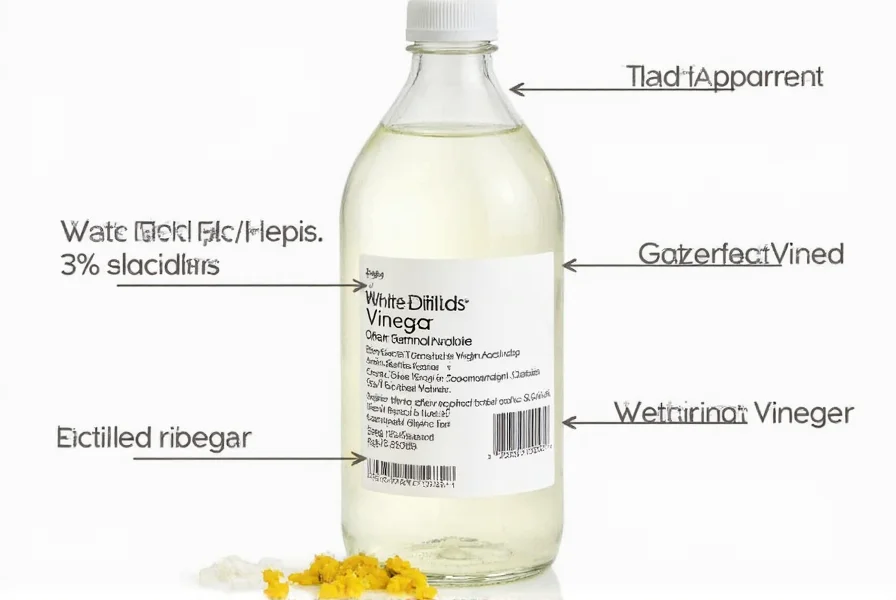Understanding the exact acidity of white distilled vinegar is essential for both culinary and household uses. The 5% acetic acid concentration represents the standard commercial formulation in most countries, including the United States and Canada. This precise measurement isn't arbitrary—it's carefully regulated to ensure consistency across products and applications.
Vinegar's acidity directly impacts its effectiveness. In cooking, this specific 5% concentration provides the right balance of tanginess without overwhelming other flavors. For pickling, it creates the proper acidic environment to safely preserve foods while maintaining texture. When used for cleaning, this acidity level effectively dissolves mineral deposits and cuts through grease without being overly corrosive to most surfaces.
Understanding Vinegar Acidity Measurements
Acidity in vinegar is measured in two primary ways:
| Measurement Type | Description | White Distilled Vinegar Value |
|---|---|---|
| Acetic Acid Percentage | Volume of pure acetic acid per 100ml of solution | 5% (standard) |
| pH Level | Measure of hydrogen ion concentration (acidity scale) | 2.4-2.6 |
The 5% measurement refers specifically to the concentration of acetic acid, vinegar's active component. This standardized concentration ensures reliable results whether you're following a pickling recipe that requires specific acidity for food safety or using vinegar to remove hard water stains.
How White Distilled Vinegar Compares to Other Vinegars
Not all vinegars share the same acidity level. The distillation process creates a consistent product, unlike many other vinegar varieties:
- Apple cider vinegar: Typically 5-6% acidity, with slight variations between brands
- Balsamic vinegar: Usually 6-7% acidity, though traditional varieties may differ
- Wine vinegar: Generally 5-7% acidity depending on production methods
- Rice vinegar: Often milder at 4-5% acidity
White distilled vinegar's consistent 5% acidity makes it the preferred choice for applications requiring precise acid concentration. This reliability explains why canning recipes specifically call for distilled white vinegar rather than other varieties.
Why Acidity Matters for Specific Applications
The 5% acetic acid concentration serves different purposes across various applications:
Culinary Uses
In cooking and food preservation, the specific 5% acidity of white distilled vinegar creates the proper environment for safe pickling. The USDA requires a minimum 5% acidity for most pickling recipes to prevent bacterial growth, particularly Clostridium botulinum. This precise acidity level also provides consistent flavor without overpowering other ingredients in dressings and marinades.
Cleaning Applications
For household cleaning, the pH level of approximately 2.5 gives white distilled vinegar enough strength to dissolve mineral deposits and sanitize surfaces, yet remains safe for most household materials when properly diluted. The consistent 5% concentration means users can rely on predictable results whether removing soap scum, disinfecting surfaces, or cleaning windows.
Gardening and Other Uses
Gardeners sometimes use diluted white vinegar for specific purposes, though the standard 5% concentration is typically too strong and requires dilution. The precise acidity level allows for accurate measurement when creating solutions for weed control or adjusting soil pH.
Safety Considerations with 5% Acidity
While white distilled vinegar's standard 5% acidity is safe for most household uses, certain precautions are necessary:
- Never mix with bleach, as this creates toxic chlorine gas
- Avoid using on natural stone surfaces like marble or granite
- Dilute properly for skin applications (undiluted vinegar can cause irritation)
- Store away from children despite being a food product
The consistent 5% concentration means users can reliably follow dilution guidelines for various applications. Higher concentration vinegars (above 10%) require special handling and are not typically available to consumers.
Verifying Vinegar Acidity
Most commercial white distilled vinegars maintain the standard 5% acidity, but verification methods exist:
- Check the product label, which must legally disclose acidity percentage
- Use pH test strips for approximate measurement
- Titration kits provide precise laboratory-grade measurements
For home canning and food preservation, always use vinegar with clearly labeled 5% acidity. Substituting vinegars with unknown or variable acidity could compromise food safety in preserved items.
Common Misconceptions About Vinegar Acidity
Several myths persist about white distilled vinegar's acidity:
- Misconception: More acidic vinegar works better for all purposes
Reality: Higher concentrations can damage surfaces and alter food safety parameters - Misconception: All white vinegars have identical acidity
Reality: Some specialty vinegars may have different concentrations—always check labels - Misconception: Vinegar acidity changes significantly over time
Reality: Properly stored vinegar maintains stable acidity for years











 浙公网安备
33010002000092号
浙公网安备
33010002000092号 浙B2-20120091-4
浙B2-20120091-4